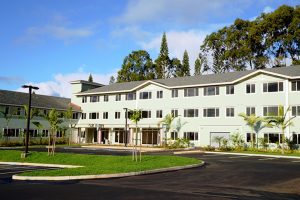Bridging the gap for better housing solutions
Posted on Feb 26, 2018 in Featured
Gov. Ige and Maui’s senior housing advocate Roy Katsuda discuss Hale Mahaolu Ewalu, an affordable rental project.
From Kaka‘ako and Kona to Mililani, Koloa and Kula, groundbreakings and blessings for more affordable housing projects are happening across the state. “The number of projects completed, under construction or in the pipeline is significant,” said Craig Hirai, director of the Hawai‘i Housing Finance and Development Corporation (HHFDC). The agency uses its financial tools and helps with infrastructure development (sewer and water) to make building affordable units feasible.
“HHFDC is concentrating on increasing the production pipeline and accelerating the delivery of homes people can afford,” said Hirai. “The greatest need right now is for rentals, and we are on schedule to add 1,204 units this year.”
Many of HHFDC’s rental projects are for residents whose incomes are at or below 60 percent of the area median income (AMI). On O‘ahu, that equates to a family of four making about $62,700 a year (median income levels vary by county). The agency also provides assistance if the project includes some affordable units at a higher AMI.
Governor Ige has put the emphasis on affordable housing for local residents and says we’re on track to produce 10,000 units statewide by the year 2020. About 5,300 units have been finished so far, with 40 percent of them affordable. Another 1,400 units are under construction and 4,500 more are in the pipeline. Senior housing projects have opened or are in the pipeline on Maui, Kaua‘i, Hawai‘i island and O‘ahu, and more affordable units for local residents are coming online each month.
Some might ask, “Why can’t we just build more affordables faster?” The answer is a Rubik’s cube of complexity that depends on timing, community need, available land, infrastructure, and the financing a developer can secure. Hirai said his agency looks for ways to maximize financing tools and leverage state funds to achieve the right mix of affordable and market-rate units. The Hawai‘i Community Development Authority also places requirements for developments in areas such as Kaka‘ako to include a certain number of affordable or “reserved” units.
The governor has been bringing people to the table — public and private — to advise him on how the state can help ramp up production. Working with legislators, the counties, and community stakeholders, the progress includes: 1) A state action team for affordable rental housing to see what land is available in each county and where the needs are to build 22,500 affordable rentals by 2026; 2) More state support to build affordables through the governor’s budget for $100 milllion to help with infrastructure, affordable unit financing and Department of Hawaiian Home Lands projects statewide; 3) More public-private partnerships to increase production and address the workforce housing gap in the 80 to 140 percent AMI category.
